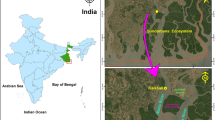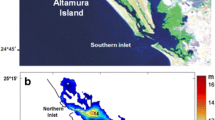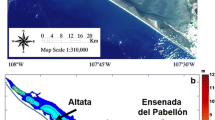Abstract
The present study reports on the vertical structure of the current profile of the Jharkhali of Sundarban ecosystem. The clay embankments constructed along the Sundarbans for coastal protection are facing severe erosion problem due to tidal current, extreme water levels, storm surges, overtopping and breaches in embankments which lead to widespread flooding. The understanding of the current profile of Sundarban aquatic system with respect to depth of water column is essential for suitable engineering design for embankment. It will be used for conservation of coastal resources and inhabitants of the Sundarbans from the natural disasters. The tidal range during the present study was 6.1 m and 5 tidal constituents viz. M2, S2, K1, O1, and N2 are predominant at Jharkhali. The minimum (114.55 cm/s) and maximum (134.45 cm/s) current speed were observed at bottom and mid depth respectively. The maximum speed at bottom is also due to longitudinal salinity gradients, which may induce larger velocities in the lower part of the water column. The vertical velocity profiles during flood are characterized by a near bed maximum. The maximum speed usually occurs during mid-flood and mid-ebb periods and also varying with moon phase, usually maximum and minimum speed were observed during spring tide and neap tide respectively. This trend is persisting in the entire water column from the surface to bottom. The direction of the current is controlled by orientation of the river channel and adjacent tributaries. In general, water travels towards North and WNW direction during flood tide and E & ESE direction during ebb tide. Interestingly, about 80-degree difference in current direction was noticed between surface and bottom current with clockwise spiral movement.












Similar content being viewed by others
References
Alves B, Angnuureng DB, Morand P et al (2020) A review on coastal erosion and flooding risks and best management practices in West Africa: what has been done and should be done. J Coast Conserv 24:38. https://doi.org/10.1007/s11852-020-00755-7
Banerjee K (2013) Decadal change in the surface water salinity profile of Indian Sundarbans: APotential Indicator of climate Change. J marine Sci res Dev S11:002. https://doi.org/10.4172/2155-9910.S11-002
Bhattacharyyaa S, Pethick J, Sarmaa KS (2013) Managerial response to sea level rise in the tidal estuaries of the Indian Sundarbans: a geomorphological approach. Water Policy. 15:51–74
Blasco F (1977) Outline of ecology, botany and forestry of the mangals of the Indian subcontinent. In: Chapman VJ (ed) Ecosystems of the world 1: wet coastal ecosystems. Elsevier, Amsterdam, pp 241–260
Bruno M, Mañanes R, Alonso JJ, Izquierdo A, Tejedor L, Kagan B (2000) Vertical structure of the semidiurnal tidal currents at Camarinal sill, the strait of Gibraltar. Oceanol Acta 23:15–24
Candela J, Winant C, Ruiz A (1990) Tides in the strait of Gibraltar. Prog Oceanogr 33:7313–7335
Chatterjee M, Shankar D, Sen GK, Sanyal P, Sundar D, Michael GS et al (2013) Tidal variations in the Sundarbans estuarine system. Journal of Earth System Science 122:899–933
Chatwin PC (1976) Some remarks on the maintenance of the salinity distribution in estuaries. Estuar Coast Shelf Sci 4:555–566
Denman KL, Powell TM (1984) Effects of physical processes on planktonic ecosystems in the coastal ocean. Oceanogr Mar Biol Annu Rev 22:125–168
Sánchez-Triana E, Ortolano L, Paul T (2018) Managing water-related risks in the West Bengal Sundarbans: policy alternatives and institutions. Int Journal of Water Resources Development 34(1):78–96. https://doi.org/10.1080/07900627.2016.1202099
Gayathri R, Bhaskaran PK, Sen D (2015) Numerical study on storm surge and associated coastal inundation for 2009 AILA cyclone in the head bay of Bengal. Aquatic Procedia 4:404–411. https://doi.org/10.1016/j.aqpro.2015.02.054
Gayathri R, Bhaskaran PK, Murty PLN (2019) River-tide-storm surge interaction characteristics for the Hooghly estuary. East coast of India ISH Journal of Hydraulic Engineering:1–13. https://doi.org/10.1080/09715010.2019.1601036
Ganguly D, Mukhopadhyay A, Pandey R, Mitra D (2006) Geomorphic study of Sundarbans deltaic estuary. J Indian Soc Rem Sens 34(4):431–435
García Lafuente J, Almazán JL, Castillejo F, Khribeche A, Hakimi A (1990) Sea level in the strait of Gibraltar: tides. Int Hydrogr Rev 47:111–130
Gole CV, Vaidyaraman PP (1967) Salinity distribution and effect of fresh water flows in the river Hooghly. In: Proc Tenth Congress of Coastal Engineering Tokyo 2:1412–1434
Goutam KS, Tanaya D, Anwesha S, Sharanya C, Meenakshi C (2015) Tide and mixing characteristics in Sundarbans Ecosystem River system. Hydrol Current Res 6:204. https://doi.org/10.4172/2157-7587.1000204
Hansen DV, Rattray M Jr (1965) Gravitational circulation in straits and estuaries. J Mar Res 23(104–22):1965
Hazra S, Ghosh T, DasGupta R, Sen G (2002) Sea level and associated changes in the Sundarbans. Sci Cult 68:309–321
Hazra, S., Samanta, K. Mukhopadhyay, A., & Akhand, A. (2010). Temporal change detection (2001- 2008) study of Sundarban. Jadavpur, Kolkata, India: School of Oceanographic Studies, Jadavpur University. Retrieved December 7, 2015, from http://www.iczmpwb.org/main/pdf/ebooks/WWF_finalreportPDF
Jonathan P, Flynn J, Ewans K (2012) Joint modelling of vertical profiles of large ocean currents. Ocean Eng 42:195–204
Lin B, Falconer RA (1997) Three-dimensional layer-integrated modelling of estuarine flows with flooding and drying, Estuarine. Coastal and Shelf Science 44:737–751
NTC Glossary (2010). Tidal Terminology; National Tidal Centre, Australian Bureau of Meteorology, PO Box 421, Kent Town, SA 5071, 41p, http://www.bom.gov.au/oceanography/projects/ntc/ntc.shtml
Parvathy KG, Umesh PA, Bhaskaran PK (2017) Inter-seasonal variability of wind-waves and their attenuation characteristics by mangroves in a reversing wind system. Int J Climatol 37(5):5089–5106. https://doi.org/10.1002/joc.5147
Pethick J, Orford JD (2013) Rapid rise in effective sea-level in Southwest Bangladesh: its causes and contemporary rates. Glob Planet Chang 111:237–245
Prandle D (1982) The vertical structure of tidal currents and other oscillatory flows. Cont Shelf Res 1(2):191–207
Richards JF, Flint EP (1990) Long-term transformations in the Sundarbans wetlands forests of Bengal. Agric Hum Values 7(2):17–33
Rose L, Bhaskaran PK, Kani SP (2015) Tidal analysis and prediction for the Gangra location, Hooghly estuary in the bay of Bengal. Curr Sci 109(4):745–758
Rose L, Bhaskaran PK, Jose F (2017) Tidal asymmetry and characteristics of tides in the Head Bay of Bengal. Q J R Meteorol Soc 143(708):2735–2740. https://doi.org/10.1002/qj.3122
Sadhuram Y, Sarma VV, Ramana Murthy TV, Prabhakara Rao B (2005) Seasonal variability of physicochemical characteristics of the Haldia channel of Hooghly estuary, India; J. earth Syst. Sci. 114:37–49
Selvin Pitchaikani PJ, Ramakrishnan R, Bhaskaran PK, Ilangovan D, Rajawat AS (2018) Development of regional algorithm to estimate suspended sediment concentration (SSC) based on the remotely sensed reflectance and field observations for the Hooghly estuary and West Bengal coastal waters. Journal of the Indian Society of Remote Sensing 47:177–183. https://doi.org/10.1007/s12524-018-0884-x
Selvin Pitchaikani J, Bhaskaran PK (2019) Tidal and non-tidal components of water level and currents in the Sundarbans ecosystem. S N Applied Sciences 1. https://doi.org/10.1007/s42452-019-1444-x
Selvin Pitchaikani J (2020) Integrated coastal zone management practices for Sundarbans, India. Indian J Geo-Mar Sci 49(03):352–356
Srinivas K, Revichandran C, Thottam TJ, Maheswaran TT, Ashraf M, Murukesh N (2000) Currents in the Cochin estuarine system (Southwest coast of India) during March 2000. Ind. J. Mar. Sci. 32(2):123–132
Stanley DJ, Hait AK (2000) Holocene depositional patterns, neotectonics and Sundarban mangroves in the western Ganges–Brahmaputra delta. J Coast Res 16(1):26–39
Sumich JL (1999) An introduction to the biology of marine life, second edn. McGraw-Hill, Boston
Tsimplis MN (2000) Vertical structure of the tidal currents over the Camarinal sill at the strait of Gibraltar. J Geophys Res 104:13541–13557
Uncles RJ, Stephens JA (1990) The structure of vertical current profiles in a macrotidal, partly-mixed estuary. Estuaries 13(4):349–361
Winterwerp, J.C., Wang, Z. B., van der Kaaij, T., Verelst, K., Bijlsma, A., Meersschaut, Y., Sas, M. (2006). Flow velocity profiles in the lower Scheldt estuary, ocean dynamics., Vol. 56: 284–294
Acknowledgments
The author is indebted to the Director, IESWM & Project Director of the Integrated Coastal Zone Management (ICZM) Project, State Project Management Unit, Department of Environment, Government of West Bengal, for the support and orientation. The author is also grateful for the comments of anonymous reviewers which helped in the clarification of the paper. The author also gratitude to Senior Scientist, Research team, Field assistants, and Coxswain for the deployment and recovery of the RDCP-600 current meter.
Author information
Authors and Affiliations
Contributions
The execution of the study, operation of the RDCP-600 current meter, data collection & analyses, data interpretation and manuscript preparation.
Corresponding author
Ethics declarations
Conflict of interests
The author declare no competing interests.
Additional information
Publisher’s note
Springer Nature remains neutral with regard to jurisdictional claims in published maps and institutional affiliations.
Rights and permissions
About this article
Cite this article
Pitchaikani, J.S. Vertical current structure in a macro-tidal, well mixed Sundarban ecosystem, India. J Coast Conserv 24, 63 (2020). https://doi.org/10.1007/s11852-020-00782-4
Received:
Revised:
Accepted:
Published:
DOI: https://doi.org/10.1007/s11852-020-00782-4




